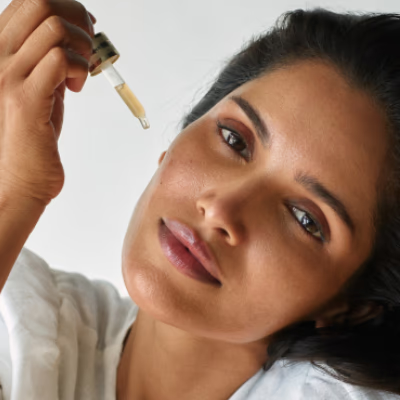
Once only found in prescription products, active ingredients have now made their way to the front labels of the most popular over-the-counter skincare brands. With skincare enthusiasts becoming more and more informed, it is not uncommon to scan the label of a skincare product before buying it. A frequently asked question remains how best to incorporate a new active into our daily skincare routine at home to ensure maximum efficacy. Read on to find out.
What are actives?
The term ‘active’ ingredient is derived from dermo-cosmetology, explains celebrity cosmetic dermatologist, and founder and CEO of Kosmoderma Clinic, Dr Chytra V Anand. “It signifies a high-impact and high-potency ingredient that is able to actively improve, treat or repair the skin condition that it is being used for,” she says.
Actives can be naturally derived or made in a lab from natural or synthetic sources. For instance, glycolic acid is a sugarcane extract and kojic acid is a mushroom extract whereas hyaluronic acid can be derived from plant, animal, or human sources.

Why are all skincare brands suddenly championing actives?
From retinol targeting anti-ageing to niacinamide battling acne scars, every active appears to be a superhero effectively combating specific skincare concerns. So, when did actives embed themselves in the mainstream lexicon?
Dr Anand believes that the spike in popularity can be traced to a paradigm shift in consumer behaviour. “Today, people are looking for effective skincare that can actively help their skin, and not act just as a troubleshooting agent. The lifecycle of beauty itself is changing with people seeking out doctors for procedures for maintenance, and not just for spot-fixing solitary concerns,” she elaborates.
Factor in the rise of bloggers and skincare experts saturating social media with information on how to use, layer, and mix the latest trending ingredients, and you have on your hands a sudden eruption in the demand for actives.
Why should you add actives to your skincare routine?
Dr Anand believes that active ingredients can be a crucial first move in your step by step skincare journey, helping you fix your concern at its root. “Actives have a clinically proven history of helping with mild conditions of acne, dry skin and dehydration. Since everyone may not have access to skin experts and clinics, developing a skincare routine with potent actives can help in mild cases,” she states.
In brief, you will find that pigmentation can be treated with glycolic acid, dehydrated skin greatly benefits from the moisture boost of hyaluronic acid and acne will most likely succumb to salicylic acid, niacinamide and retinol liposomes.
What precautions need to be taken when adding or mixing actives in a skincare routine?
There’s something about mixing and layering new actives in different skincare routine steps that can make you feel like a chemist in a lab. However, it helps to note that the best skincare routine does not just mean using all the actives you can. Not all actives are compatible with each other and a few of them may not be suitable for your skin type either. Dr Anand cautions that ignoring these general precautions can lead to skin irritation, rashes, pigmentation and, in certain cases, even burns caused due to overuse of potent ingredients. Resort to some quick research before diving into the world of skincare cocktails.
How can you safely introduce a new active in your routine without any side effects?
The road to understanding the benefits that actives can bring to your skincare regimen comes from knowing whether you need one. “Over the age of 25, the process of ageing sets in and the skin cells get sluggish. This is when actives can play a significant role in stimulating skin cells and aiding skin repair and recovery,” says Dr Anand. The standard protocol applies when introducing a new active to your routine: always patch-test the formula on clean skin first and leave it on overnight before starting a dedicated regimen. “In case you are looking to tap into the benefits of different actives, it helps to look for pre-blended, multi-ingredient formulas instead of attempting to mix or layer too many actives on your own,” she adds.
Once your skin develops a level of comfort with one active, you can choose to add another to your routine—just as long as you follow due precaution. “Apply one active and after one week has passed, introduce the second active to your skin in a gentle, phased manner. Make sure that you don’t overuse the product and in case of any tingling on the skin or burning, wash it off with cool water and follow up with moisturiser at night to soothe the skin,” she concludes.







.PNG)
.PNG)
.PNG)
.PNG)
.PNG)

















